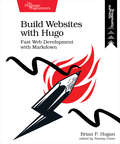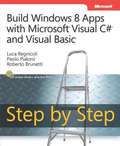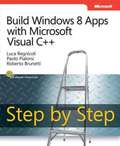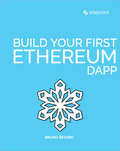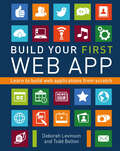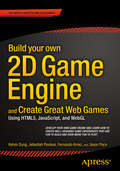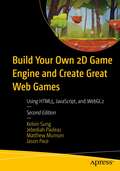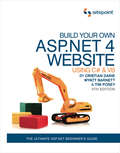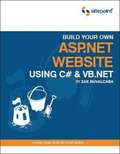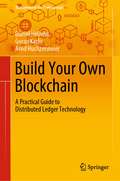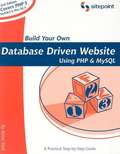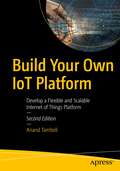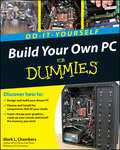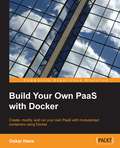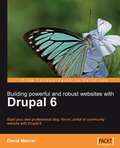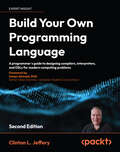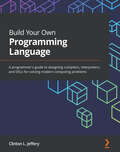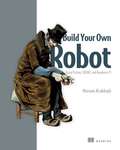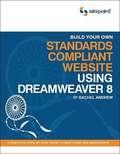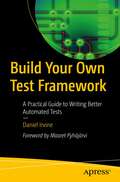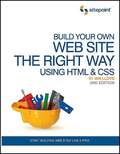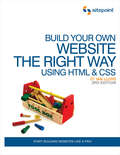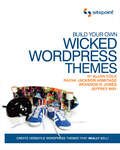- Table View
- List View
Build Websites with Hugo: Fast Web Development With Markdown
by Brian P. HoganDatabase-driven sites bring complexity you might not need, but building a site by hand is too much work. Hugo is a static site generator and web development framework that creates content sites quickly without the overhead or dependencies of a dyanmic web framework. With Hugo, you use HTML templates and Markdown to build static sites you can host anywhere, letting you use the skills you already have. Develop your own theme using standard HTML and CSS, using Hugo’s powerful templating features to organize your site’s components. Create your site’s content with HTML or Markdown and use Hugo’s content templating features to build new content quickly. Build a fully-featured blog with archive pages, tagging, and pagination, and integrate an external commenting system to provide interactivity. Use data from front-matter, site-wide configuration, and external JSON sources to add content, and generate JSON others can use. Integrate JavaScript with your site to create a search engine. Get Hugo working with Webpack so you can leverage the wider web development ecosystem, and explore ways to publish your site to various services. Finally, learn how you can move your existing content site to Hugo. Dive in and build your next site with Hugo!
Build Windows® 8 Apps with Microsoft® Visual C#® and Visual Basic® Step by Step
by Paolo Pialorsi Roberto Brunetti Luca Regnicoli<div><p>NOTE: This book is based on Windows 8 Release Preview; its content and publication date will be updated for final Windows 8 software.\n</p><p>Teach yourself how to build Windows 8 applications using Microsoft® .NET Framework 4.5 with Microsoft Visual C# 2012 or Visual Basic 2012—one step at a time. Ideal for those with intermediate to advanced .NET development skills, this tutorial provides practical, learn-by-doing exercises for creating apps that easily adapt to different screen sizes—including desktop and laptop computers, tablets, and slates.</p></div>
Build Windows® 8 Apps with Microsoft® Visual C++® Step by Step
by Paolo Pialorsi Roberto Brunetti Luca RegnicoliYour hands-on, step-by-step guide to building Windows 8 apps with Microsoft® Visual C++® Teach yourself how to build Windows 8 applications using the Visual C++ language--one step at a time. Ideal for those with intermediate to advanced C++ development skills, this tutorial provides practical, learn-by-doing exercises for creating apps that can adapt to different screen sizes--including desktop and laptop computers, tablets, and slates. Discover how to: Build apps using Windows 8 design guidelines Explore the Windows 8 application architecture Apply tools and libraries from Microsoft® Visual Studio® and the Windows 8 SDK Use XAML to create touch-optimized user interfaces Create apps that make use of device sensors Manage the Windows 8 application lifecycle Prepare your app for the Windows Store
Build Your First Ethereum DApp
by Bruno SkvorcIn this book we'll walk through the creation of a complete distributed application (DApp) based on the Ethereum platform. We'll be building The Neverending Story, a crowdsourced choose-your-own-adventure story with crowd curation and community censorship. This book is for anyone interested in using the Ethereum platform for development. It's advised that you read The Developer's Guide to Ethereum before reading this book if you are not familiar with blockchain technology.
Build Your First Web App: Learn to Build Web Applications from Scratch
by Deborah Levinson Todd BeltonNot a techie? Don&’t worry! This friendly and approachable guide shows even complete beginners how to build their first web application. Modern web application design and development can feel overwhelming: How do you design a useful tool that can run on a desktop, tablet, and phone? Which programming framework should you use? How can a non-programmer pick up these skills? Build Your First Web App answers these questions by teaching two popular practical frameworks, Bootstrap and Angular.js, as well as the principles behind programming: the basics of user experience design, planning and structuring your software, and making your application visually attractive and easier to use. The book walks you through every step of creating you first app, and gives you assignments in each chapter. If you already know some HTML and CSS, but want to go further and create something functional rather than static, this book is for you!Book includes:An overview of the app design planning process—scenario development, feature/flow design through wireframing, and user research.Quick tips for adding visual design intelligently to make the application easier to understand and use.A walkthrough of how to code a sample app using a responsive framework (Bootstrap) and Angular.js. Each chapter of the book covers a different part of the sample app, allowing readers to follow along and draft their own code.
Build Your Own 2D Game Engine and Create Great Web Games: Using HTML5, JavaScript, and WebGL
by Jebediah Pavleas Kelvin Sung Fernando Arnez Jason PaceBuild Your Own 2D Game Engine and Create Great Web Games teaches you how to develop your own web-based game engine step-by-step, allowing you to create a wide variety of online videogames that can be played in common web browsers. Chapters include examples and projects that gradually increase in complexity while introducing a ground-up design framework, providing you with the foundational concepts needed to build fun and engaging 2D games. By the end of this book you will have created a complete prototype level for a side scrolling action platform game and will be prepared to begin designing additional levels and games of your own. This book isolates and presents relevant knowledge from software engineering, computer graphics, mathematics, physics, game development, game mechanics, and level design in the context of building a 2D game engine from scratch. The book then derives and analyzes the source code needed to implement these concepts based on HTML5, JavaScript, and WebGL. After completing the projects you will understand the core-concepts and implementation details of a typical 2D game engine and you will be familiar with a design and prototyping methodology you can use to create game levels and mechanics that are fun and engaging for players. You will gain insights into the many ways software design and creative design must work together to deliver the best game experiences, and you will have access to a versatile 2D game engine that you can expand upon or utilize directly to build your own 2D games that can be played online from anywhere. What you'll learn * Understand essential concepts for building 2D games * Understand basic architecture of 2D game engines * Understand illumination models in 2D games * Understand basic physics in 2D games * Understand how these core concepts affect game design and game play * Be able to build simple 2D game engines * Be able to design and develop 2D interactive games that are fun to play Who this book is for Build your own 2D Game Engine and Create Great Web Games is perfect for game enthusiasts, hobbyists, and anyone who is interested in building interactive games but is unsure of how to begin. Build your own 2D Game Engine and Create Great Web Games can also serve as a textbook for a Junior- or Senior-level "Introduction to Game Engine" elective course in a Computer Science department. Table of Contents Chapter 1: Introducing 2D Game Engine Development with JavaScript Chapter 2: Working with HTML5 and WebGL Chapter 3: Drawing Objects in the World Chapter 4: Implementing Common Components of Video Games Chapter 5: Working with Textures, Sprites, and Fonts Chapter 6: Defining Behaviors and Detecting Collisions Chapter 7: Manipulating the Camera Chapter 8: Implementing Illumination and Shadows Chapter 9: Building the Game Engine Architecture Chapter 10: Understanding and Supporting Game States Chapter 11: Building A Sample Game: from design to complete
Build Your Own 2D Game Engine and Create Great Web Games: Using HTML5, JavaScript, and WebGL2
by Jebediah Pavleas Kelvin Sung Jason Pace Matthew MunsonDevelop a 2D game engine that will give you the experience and core understanding of foundational concepts for building complex and fun 2D games that can be played across the Internet via popular web browsers. This book is organized so that the chapters follow logical steps of building a game engine and integrates concepts accordingly. Build Your Own 2D Game Engine and Create Great Web Games isolates and presents relevant concepts from software engineering, computer graphics, mathematics, physics, game development and game design in the context of building a 2D game engine from scratch. In this edition, all the code is based on updated versions of JavaScript with HTML5 and WebGL2: you will analyze the source code needed to create a game engine that is suitable for implementing typical casual 2D videogames. You will also learn about physics and particle system. The discussion of physics component includes rotations and popular physical materials such as wood, mud, and ice. The discussion of particle component has popular presets such as fire, smoke, and dust. By the end of the book, you will understand the core concepts and implementation details of a typical 2D game engine, learn insights into how these concepts affect game design and game play, and have access to a versatile 2D game engine that they can expand upon or utilize to build their own 2D games from scratch with HTML5, JavaScript, and WebGL2. What You Will Learn Understand essential concepts for building 2D gamesGrasp the basic architecture of 2D game enginesUnderstand illumination models in 2D gamesLearn basic physics used in 2D gamesFind out how these core concepts affect game design and game playLearn to design and develop 2D interactive games Who Is This Book For Game enthusiasts, hobbyists, and anyone with little to no experience who are interested in building interactive games but are unsure of how to begin. This can also serve as a textbook for a junior- or senior-level "Introduction to Game Engine" course in a Computer Science department.
Build Your Own ASP.NET 4 Web Site Using C# & VB, 4th Edition: Using C# & VB
by Cristian Darie Timmothy Posey Wyatt BarnettBuild Your Own ASP.NET 4 Web Site Using C# & VB is aimed at beginner ASP.NET developers wanting to develop their skills, web designers wanting to move into server-side programming, and experienced developers making the leap from ASP to .NET.Readers will learn:language and programming basicshow to construct ASP.Net Web Pageshow to build web applicationsto use validation controlsdatabase design and developmenthow to use ADO.NEThow to manage data and contenthow to integrate Ajax and jQuerythe role of MVC... all in the process of successfully developing and deploying a working intranet site for a fictional company.
Build Your Own ASP.NET Website Using C# & VB.NET
by Zak RuvalcabaA tutorial style book for absolute beginners that walks readers through an introduction to databases and programming concepts and then shows them how to build practical applications using Microsoft's technology. Build Your Own ASP.NET Website Using C# & VB.NET guides readers through obtaining, installing and configuring all the necessary software to develop dynamic Websites. Then, it takes readers step-by-step through the process of creating full-blown, practical applications including an intranet, shopping cart with Paypal credit card processing and more. Throughout, the book focuses on best-practice code, ensuring application security and creating professional error handling routines. Unlike most beginner books, SitePoint allow readers to choose between two programming languages, VB.NET or c#, when creating any of the applications in the book.
Build Your Own Blockchain: A Practical Guide to Distributed Ledger Technology (Management for Professionals)
by Arnd Huchzermeier Daniel Hellwig Goran KarlicThis book provides a comprehensive introduction to blockchain and distributed ledger technology. Intended as an applied guide for hands-on practitioners, the book includes detailed examples and in-depth explanations of how to build and run a blockchain from scratch. Through its conceptual background and hands-on exercises, this book allows students, teachers and crypto enthusiasts to launch their first blockchain while assuming prior knowledge of the underlying technology. How do I build a blockchain? How do I mint a cryptocurrency? How do I write a smart contract? How do I launch an initial coin offering (ICO)? These are some of questions this book answers. Starting by outlining the beginnings and development of early cryptocurrencies, it provides the conceptual foundations required to engineer secure software that interacts with both public and private ledgers. The topics covered include consensus algorithms, mining and decentralization, and many more. “This is a one-of-a-kind book on Blockchain technology. The authors achieved the perfect balance between the breadth of topics and the depth of technical discussion. But the real gem is the set of carefully curated hands-on exercises that guide the reader through the process of building a Blockchain right from Chapter 1.” Volodymyr Babich, Professor of Operations and Information Management, McDonough School of Business, Georgetown University"An excellent introduction of DLT technology for a non-technical audience. The book is replete with examples and exercises, which greatly facilitate the learning of the underlying processes of blockchain technology for all, from students to entrepreneurs.” Serguei Netessine, Dhirubhai Ambani Professor of Innovation and Entrepreneurship, The Wharton School, University of Pennsylvania"Whether you want to start from scratch or deepen your blockchain knowledge about the latest developments, this book is an essential reference. Through clear explanations and practical code examples, the authors take you on a progressive journey to discover the technology foundations and build your own blockchain. From an operations perspective, you can learn the principles behind the distributed ledger technology relevant for transitioning towards blockchain-enabled supply chains. Reading this book, you'll get inspired, be able to assess the applicability of blockchain to supply chain operations, and learn from best practices recognized in real-world examples." Ralf W. Seifert, Professor of Technology and Operations Management at EPFL and Professor of Operations Management at IMD
Build Your Own Car Dashboard with a Raspberry Pi: Practical Projects to Build Your Own Smart Car
by Joseph CoburnCreate your own car engine control unit (ECU) with a simple Raspberry PI while building the necessary skills to produce future more advanced projects. Once you've worked through the projects in this book, you'll have a smart car and the coding knowledge needed to develop advanced hardware and software projects.Start by understanding how the Pi works, and move on to how to build hardware projects, use the GPIO pins, and install the system. Then add to that a solid understanding of software development principles and best practices, along with a good grasp of Python (v3.6+) and Python/software best practices. More than just how to code in Python, you'll learn what it takes to write production grade software, defensive code, testing, deployments, version control, and more. Internalize industry best practices while going further with valuable software development techniques such as defensive programming.The concepts introduced are essential to ensuring that software can function under unexpected circumstances. Can you imagine what would happen if your mobile phone could not cope with a call from an unknown number, or you had to set you microwave in increments of 6 seconds? While testing avoids edge cases such as these, defensive programming is one of the building blocks of software development.What You'll LearnHone test driven development in Python skillsDebug software and hardware project installationsWork with the GPIO ports of the Pi to feed your software real-world hardware informationWho This Book Is ForPeople who like working on cars and want to learn Raspberry Pi and software development but don’t know where to start.
Build Your Own Database-Driven Website Using PHP and MySQL, Third Edition
by Kevin YankBuild Your Own Database-Driven Website Using PHP and MySQL is a practical guide for first-time users of PHP and MySQL that teaches readers by creating a fully working Content Management System, Shopping Cart and other real-world applications. There has been a marked increase in the adoption of PHP, most notably in the beginning to intermediate levels. PHP now boasts over 30% of the server side scripting market (Source: http://www.php.weblogs.com ). The previous edition sold over 17,000 copies exclusively through http://www.sitepoint.com alone. With the release of PHP 5, SitePoint have updated this bestseller to reflect best practice web development using PHP 5 and MySQL 4. The 3rd Edition includes more code examples and also a new bonus chapter on structured PHP Programming which introduces techniques for organizing real world PHP applications to avoid code duplication and ensure code is manageable and maintainable. The chapter introduces features like include files, user-defined function libraries and constants, which are combined to produce a fully functional access control system suitable for use on any PHP Website.
Build Your Own IoT Platform: Develop a Flexible and Scalable Internet of Things Platform
by Anand TamboliEvery solution that is in some way related to the IoT needs a platform; learn how to create that platform with us. This book is about being agile and reducing your time to market without breaking the bank. It is about designing something that can scale incrementally without rework and potentially disrupting the current work.So, the key questions are: What does it take? How long does it take? And, how much does it take to build your own IoT platform? This book answers these questions and provides you with step-by-step guide to building your own IoT platform. In this book, the author highlights what the core of an IoT platform looks like. There are always some must-haves and some nice-to-haves. This book distinguishes the two and focuses on building the must-haves. Building your IoT platform is not only the most significant cost-saver but can also be a satisfying learning experience. This edition will extend your work with a sample project to clarify the concepts and show you the possibilities. Additional chapters will also shed some light on the hardware interface and considerations.What You Will Learn· Master how to architect an interconnected system and develop a flexible platform architecture· Understand how to prioritize system requirements with a bottom-up approach· Design and build a robust IoT communications platform· Create an end-to-end application using guidelines in this book Who Is This Book ForIoT developers with basic-to-intermediate programming skills, small business owners, as well as entrepreneurs and startup founders would benefit from this book
Build Your Own PC Do-It-Yourself For Dummies
by Mark L. ChambersIf you've dreamed about having a customized multimedia PC or one tricked out for your favorite games, build your own and make your dreams come true! Build Your Own PC Do-It-Yourself For Dummies makes it easy. Not only is building your own PC a really rewarding project, it can also save you a nice chunk of cash. This step-by-step guide helps you decide what you need, teaches you what all those computer terms mean, and tells you exactly how to put the pieces together. It shows you: What tools you need (not as many as you might think!) All about operating systems How to install CD and DVD drives The scoop on sound and video, and how to put a sound system together from start to finish How to connect a monitor and install a modem All about setting up and configuring the hard drive Secrets for securing your system, and more Included is a bonus DVD showing you how to install the motherboard, CPU, RAM, ports, hard drive, video and sound cards, a DVD drive, and more. With Build Your Own PC Do-It-Yourself For Dummies, you can have the computer you want plus the satisfaction of doing it yourself! Note: CD-ROM/DVD and other supplementary materials are not included as part of eBook file.
Build Your Own PaaS with Docker
by Oskar HaneThis book is intended for those who want to take full advantage of separating services into module containers and connect them to form a complete platform. It will give you all the insights and knowledge needed to run your own PaaS.
Build Your Own Professional Blog, Forum, Portal or Community Website with Drupal 6
by David MercerDescription of how to design and build a web site using the Drupal CMS tool.
Build Your Own Programming Language: A programmer's guide to designing compilers, interpreters, and DSLs for modern computing problems
by Clinton L. JefferyLearn to design your own programming language in a hands-on way by building compilers, using preprocessors, transpilers, and more, in this fully-refreshed second edition, written by the creator of the Unicon programming language. Purchase of the print or Kindle book includes a free PDF eBookKey FeaturesTakes a hands-on approach; learn by building the Jzero language, a subset of Java, with example code shown in both the Java and Unicon languagesLearn how to create parsers, code generators, scanners, and interpretersTarget bytecode, native code, and preprocess or transpile code into a high-level languageBook DescriptionThere are many reasons to build a programming language: out of necessity, as a learning exercise, or just for fun. Whatever your reasons, this book gives you the tools to succeed. You’ll build the frontend of a compiler for your language and generate a lexical analyzer and parser using Lex and YACC tools. Then you’ll explore a series of syntax tree traversals before looking at code generation for a bytecode virtual machine or native code. In this edition, a new chapter has been added to assist you in comprehending the nuances and distinctions between preprocessors and transpilers. Code examples have been modernized, expanded, and rigorously tested, and all content has undergone thorough refreshing. You’ll learn to implement code generation techniques using practical examples, including the Unicon Preprocessor and transpiling Jzero code to Unicon. You'll move to domain-specific language features and learn to create them as built-in operators and functions. You’ll also cover garbage collection. Dr. Jeffery’s experiences building the Unicon language are used to add context to the concepts, and relevant examples are provided in both Unicon and Java so that you can follow along in your language of choice. By the end of this book, you'll be able to build and deploy your own domain-specific language.What you will learnAnalyze requirements for your language and design syntax and semantics.Write grammar rules for common expressions and control structures.Build a scanner to read source code and generate a parser to check syntax.Implement syntax-coloring for your code in IDEs like VS Code.Write tree traversals and insert information into the syntax tree.Implement a bytecode interpreter and run bytecode from your compiler.Write native code and run it after assembling and linking using system tools.Preprocess and transpile code into another high-level languageWho this book is forThis book is for software developers interested in the idea of inventing their own language or developing a domain-specific language. Computer science students taking compiler design or construction courses will also find this book highly useful as a practical guide to language implementation to supplement more theoretical textbooks. Intermediate or better proficiency in Java or C++ programming languages (or another high-level programming language) is assumed.
Build Your Own Programming Language: A programmer's guide to designing compilers, interpreters, and DSLs for solving modern computing problems
by Clinton L. JefferyWritten by the creator of the Unicon programming language, this book will show you how to implement programming languages to reduce the time and cost of creating applications for new or specialized areas of computingKey FeaturesReduce development time and solve pain points in your application domain by building a custom programming languageLearn how to create parsers, code generators, file readers, analyzers, and interpretersCreate an alternative to frameworks and libraries to solve domain-specific problemsBook DescriptionThe need for different types of computer languages is growing rapidly and developers prefer creating domain-specific languages for solving specific application domain problems. Building your own programming language has its advantages. It can be your antidote to the ever-increasing size and complexity of software.In this book, you'll start with implementing the frontend of a compiler for your language, including a lexical analyzer and parser. The book covers a series of traversals of syntax trees, culminating with code generation for a bytecode virtual machine. Moving ahead, you'll learn how domain-specific language features are often best represented by operators and functions that are built into the language, rather than library functions. We'll conclude with how to implement garbage collection, including reference counting and mark-and-sweep garbage collection. Throughout the book, Dr. Jeffery weaves in his experience of building the Unicon programming language to give better context to the concepts where relevant examples are provided in both Unicon and Java so that you can follow the code of your choice of either a very high-level language with advanced features, or a mainstream language.By the end of this book, you'll be able to build and deploy your own domain-specific languages, capable of compiling and running programs.What you will learnPerform requirements analysis for the new language and design language syntax and semanticsWrite lexical and context-free grammar rules for common expressions and control structuresDevelop a scanner that reads source code and generate a parser that checks syntaxBuild key data structures in a compiler and use your compiler to build a syntax-coloring code editorImplement a bytecode interpreter and run bytecode generated by your compilerWrite tree traversals that insert information into the syntax treeImplement garbage collection in your languageWho this book is forThis book is for software developers interested in the idea of inventing their own language or developing a domain-specific language. Computer science students taking compiler construction courses will also find this book highly useful as a practical guide to language implementation to supplement more theoretical textbooks. Intermediate-level knowledge and experience working with a high-level language such as Java or the C++ language are expected to help you get the most out of this book.
Build Your Own Robot: Using Python, CRICKIT, and Raspberry PI
by Marwan AlsabbaghA DIY guide to bringing your first robot to life with cheap and basic components.Build Your Own Robot introduces you to the exciting world of robotics in a way that&’s fun and affordable! You&’ll build your own real robot with easy-to-find hardware and free open source software. Plus, all the components you need can be assembled with simple tools like a screwdriver. In Build Your Own Robot you&’ll learn how to: Use cameras to capture photos and let your robot see Add cameras and basic computer vision Coordinate DC motors to move your robot Write a web app to control your robot Set up controls for joysticks Read QR codes to find and identify objects This book shows you how anyone can start building their own robot—no special soldering or electronic skills required. All you need is some basic Python know-how to get started. From scratch, you&’ll go hands-on with DC motors, touch sensors, custom shell scripting, joystick controls, and even face detection for your robot friend. About the technology You can build your own robot! With this book, you&’ll use readily-available hardware and author Marwan Alsabbagh&’s clear step-by-step instructions to create a robot that moves, manipulates objects, and responds to its environment. Along the way, you&’ll learn some serious skills like computer vision, networking, and the basics of robotics programming. About the book Build Your Own Robot is a project-based guide that takes you from spinning your first DC motor to programming a mobile robot that you can control from your phone or computer. You&’ll write simple Python code to help your new friend spin, move, and find its way. You&’ll even teach it to track faces and fetch snacks. Plus, a helpful hardware purchasing guide makes it easy to find exactly what you need to get started! What's inside Coordinate DC motors to move your robot Write a web app to control your robot Adding cameras and basic computer vision Read QR codes to find and identify objects About the reader Examples use simple Python code. No special skills or expensive tools required. About the author Marwan Alsabbagh is a seasoned software developer, who has studied mathematics and computer science at McGill University. The technical editor on this book was Alexander Ryker. Table of Contents 1 What is a robot? 2 Getting started 3 Driving the robot 4 Creating a robot shell 5 Controlling robots remotely 6 Creating robot web apps 7 Joystick-controlled robots 8 Keyboard-controlled camera 9 Face-following camera 10 Robotic QR code finder 11 Building a snack-pushing robot A Hardware purchasing guide B Configuring the Raspberry Pi C Robot assembly guide D Mocking the CRICKIT library
Build Your Own Standards Compliant Website Using Dreamweaver 8
by Rachel AndrewBuild Your Own Standards Compliant Website with Dreamweaver 8 is written for any user of Dreamweaver who wants to create standards compliant, usable and fully accessible websites. By applying Web Standards and best-practices, readers will learn to create fast-loading, easy-to-maintain and cross-browser compatible Websites. This book focuses on using XHTML and semantic markup, CSS Layouts, and accessibility guidelines to show users how to make the most of Dreamweaver 8.
Build Your Own Test Framework: A Practical Guide to Writing Better Automated Tests
by Daniel IrvineLearn to write better automated tests that will dramatically increase your productivity and have fun while doing so. This book is a build-your-own adventure designed for individual reading and for collaborative workshops. You will build an xUnit automated test framework using JavaScript: initially a clone of Jest, but adding a couple of neat features borrowed from RSpec, the genre-defining tool for behavior-driven development (BDD). Along the way, you will explore the philosophy behind automated testing best practices. The automated test runner is one of the most important innovations within software engineering. But for many programmers, automated testing remains a mystery, and knowing how to write good tests is akin to sorcery.As the chapters of this book unfold, you will see how the humble test runner is an elegant and simple piece of software. Each chapter picks a single feature to build, like the "it" function or the "beforeEach" block. It picks apart the theory of why the feature needs to exist, and how to use it effectively in your own test suites. Every chapter ends with a set of ideas for extension points should you wish to explore further, alone or in groups. The book culminates in an implementation of test doubles and mocks—one of the most difficult and misunderstood concepts within automated testing.By the end of the book, you will have gained a solid understanding of automated testing principles that you can immediately apply to your work projects. What You'll LearnBuild an xUnit automated test frameworkSee how an automated test runner worksUnderstand the best practices for automated unit testingEffectively use test doubles and mocksWho This Book Is ForSoftware developers with JavaScript experience who are seeking to master the art of automated testing.
Build Your Own Web Site the Right Way Using HTML & CSS (2nd Edition)
by Ian LloydBuild Your Own Website The Right Way Using HTML & CSS, 2nd Edition teaches web development from scratch, without assuming any previous knowledge of HTML, CSS or web development techniques. This book introduces you to HTML and CSS as you follow along with the author, step-by-step, to build a fully functional web site from the ground up. However, unlike countless other "learn web design" books, this title concentrates on modern, best-practice techniques from the very beginning, which means you'll get it right the first time. The web sites you'll build will: Look good on a PC, Mac or Linux computer Render correctly whether your visitors are using Internet Explorer, Firefox, Opera, or Safari Use web standards so your sites will be fast loading and easy to maintain Be accessible to disabled users who use screen readers to browse the Web By the end of the book, you'll be equipped with enough knowledge to set out on your first projects as a professional web developer, or you can simply use the knowledge you've gained to create attractive, functional, usable and accessible sites for personal use.
Build Your Own Website The Right Way Using HTML & CSS: Start Building Websites Like a Pro!
by Ian LloydWith over 60,000 copies sold since its first edition, this SitePoint best-seller has just had a fresh update to include recent advances in the web industry.With the first two editions coming highly recommended by established, leading web designers and developers, the third edition with all its extra goodies will continue that trend. Also fully updated to include the latest operating systems, web browsers and providing fixes to issues that have cropped up since the last edition.Readers will learn to:Style text and control your page layout with CSSCreate and Optimize graphics for the WebAdd interactivity to your sites with formsInclude a custom search, contact us page, and a News/Events section on your siteTrack visitors with Google AnalyticsExtend your reach and connect your site with Social MediaUse HTML5&CSS3 to add some cool, polished features to your siteUse diagnosis/debug tools to find any problemsAnd lots more.
Build Your Own Website: A Comic Guide to HTML, CSS, and WordPress
by Nate CooperBuild Your Own Website is a fun, illustrated introduction to the basics of creating a website. Join Kim and her little dog Tofu as she learns HTML, the language of web pages, and CSS, the language used to style web pages, from the Web Guru and Glinda, the Good Witch of CSS.Once she figures out the basics, Kim travels to WordPress City to build her first website, with Wendy, the WordPress Maven, at her side. They take control of WordPress® themes, install useful plugins, and more.As you follow along, you’ll learn how to:–Use HTML tags–Make your site shine with CSS–Customize WordPress to fit your needs–Choose a company to host your site and get advice on picking a good domain nameThe patient, step-by-step advice you’ll find in Build Your Own Website will help you get your website up and running in no time. Stop dreaming of your perfect website and start making it!
Build Your Own Wicked Wordpress Themes: Create Versatile Wordpress Themes That Really Sell!
by Alan Cole Raena Jackson Armitage Brandon R. Jones Jeffrey WayWicked WordPress Themes is a step-by-step guide to creating beautiful themes for the world's most popular CMS, WordPress.By following the book's advice, readers can produce designs that are aesthetically stunning, consistent, and for-purpose -whether it's for their own use, or to drive a high price on the theme marketplace.All facets of theme design are covered: from design, coding, and deployment, to ensuring readers' designs are ready-to-go as soon as they're installed. Wicked WordPress Themes teaches readers how to leverage theme design frameworks to dramatically shorten development time, enabling them to enter the theme market faster.
